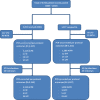Trends and predictive factors for treatment failure following artemisinin-based combination therapy among children with uncomplicated malaria in Ghana: 2005-2018
- PMID: 34911501
- PMCID: PMC8672499
- DOI: 10.1186/s12879-021-06961-4
Trends and predictive factors for treatment failure following artemisinin-based combination therapy among children with uncomplicated malaria in Ghana: 2005-2018
Abstract
Background: Since the introduction of artemisinin-based combination therapy (ACT) in Ghana in 2005 there has been a surveillance system by the National Malaria Control Programme (NMCP) and the University of Ghana Noguchi Memorial Institute for Medical Research (UG-NMIMR) to monitor the therapeutic efficacy of ACTs for the treatment of uncomplicated malaria in the country. We report trends and determinants of failure following treatment of Ghanaian children with artesunate-amodiaquine (ASAQ) and artemether-lumefantrine (AL) combinations.
Methods: Per protocol analyses as well as cumulative incidence of day 28 treatment failure from Kaplan Meier survival analyses were used to describe trends of failure over the surveillance period of 2005-2018. Univariable and multivariable cox regression analyses were used to assess the determinants of treatment failure over the period.
Results: Day 28 PCR-corrected failure, following treatment with ASAQ, significantly increased from 0.0% in 2005 to 2.0% (95% CI: 1.1-3.6) in 2015 (p = 0.013) but significantly decreased to 0.4% (95% CI: 0.1-1.6) in 2018 (p = 0.039). Failure, following treatment with AL, decreased from 4.5% (95% CI: 2.0-9.4) in 2010 to 2.7% (95% CI: 1.4-5.1) in 2018, though not statistically significant (p = 0.426). Risk of treatment failure, from multivariable cox regression analyses, was significantly lower among children receiving ASAQ compared with those receiving AL (HR = 0.24; 95% CI: 0.11-0.53; p < 0.001); lower among children with no parasitaemia on day 3 compared with those with parasitaemia on day 3 (HR = 0.02; 95% CI: 0.01-0.13; p < 0.001); and higher among children who received ASAQ and had axillary temperature ≥ 37.5 °C on day 1 compared with those with axillary temperature < 37.5 °C (HR = 3.96; 95% CI: 1.61-9.75; p = 0.003).
Conclusions: Treatment failures for both ASAQ and AL have remained less than 5% (below WHO's threshold of 10%) in Ghana since 2005. Predictors of treatment failure that need to be considered in the management of uncomplicated malaria in the country should include type of ACT, day 3 parasitaemia, and day 1 axillary temperature of patients being treated.
Keywords: ACTs; Ghana; Predictive factors; Treatment failure; Trends.
© 2021. The Author(s).
Conflict of interest statement
The authors declare that they have no competing interests.
Figures





References
-
- World Health Organization and UNICEF . World malaria report 2005. Geneva: World Health Organization; 2005.
-
- World Health Organization . World malaria report 2019. Geneva: World Health Organization; 2019.
-
- Ghana Statistical Service (GSS) and ICF . Ghana Malaria Indicator Survey 2019. Accra: GSS and ICF; 2020.
-
- World Health Organization. Global Technical Strategy for Malaria 2016–2030. https://www.who.int/docs/default-source/documents/global-technical-strat...? Accessed 4 Nov 2020.
MeSH terms
Substances
Grants and funding
LinkOut - more resources
Full Text Sources
Medical

